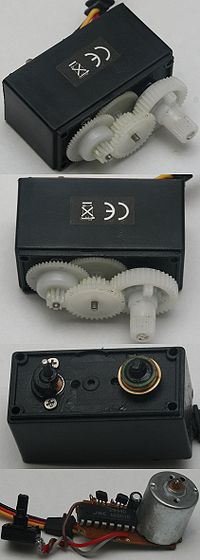
Servo (radio control)
Encyclopedia
Servos are small, cheap, mass-produced actuator
s used for radio control
and small robotics
.
Most servos are rotary actuator
s although other types are available. Linear actuator
s are sometimes used, although it is more common to use a rotary actuator with a bellcrank and pushrod. Some types, originally used as sail winches for model yachts, can rotate continuously.
 A typical servo consists of a small electric motor driving a train of reduction gears. A potentiometer
A typical servo consists of a small electric motor driving a train of reduction gears. A potentiometer
is connected to the output shaft. Some simple electronics provide a closed-loop servomechanism.
If the servo position changes from that commanded, whether this is because the command changes, or because the servo is mechanically pushed from its set position, the error signal will re-appear and cause the motor to restore the servo output shaft to the position needed.
Almost all modern servos are proportional servos, where this commanded position can be anywhere within the range of movement. Early servos, and a precursor device called an escapement, could only move to a limited number of set positions.
) signal. Each servo has a separate connection and PWM signal from the radio control receiver.
This signal is easily generated by simple electronics, or by microcontroller
s such as the Arduino
. This, together with their low-cost, has led to their wide adoption for robotics
and physical computing
.
Actuator
An actuator is a type of motor for moving or controlling a mechanism or system. It is operated by a source of energy, usually in the form of an electric current, hydraulic fluid pressure or pneumatic pressure, and converts that energy into some kind of motion. An actuator is the mechanism by which...
s used for radio control
Radio control
Radio control is the use of radio signals to remotely control a device. The term is used frequently to refer to the control of model vehicles from a hand-held radio transmitter...
and small robotics
Robotics
Robotics is the branch of technology that deals with the design, construction, operation, structural disposition, manufacture and application of robots...
.
Most servos are rotary actuator
Rotary actuator
A rotary actuator is an actuator that produces a rotary motion or torque.The simplest actuator is purely mechanical, where linear motion in one direction gives rise to rotation. The most common actuators though are electrically powered...
s although other types are available. Linear actuator
Linear actuator
A linear actuator is an actuator that creates linear motion .Mechanical and hydraulic actuation are the most common methods of achieving the linear motion...
s are sometimes used, although it is more common to use a rotary actuator with a bellcrank and pushrod. Some types, originally used as sail winches for model yachts, can rotate continuously.
Construction

Potentiometer
A potentiometer , informally, a pot, is a three-terminal resistor with a sliding contact that forms an adjustable voltage divider. If only two terminals are used , it acts as a variable resistor or rheostat. Potentiometers are commonly used to control electrical devices such as volume controls on...
is connected to the output shaft. Some simple electronics provide a closed-loop servomechanism.
Operation
The position of the output, measured by the potentiometer, is continually compared to the commanded position from the control (i.e. the radio control). Any difference gives rise to an error signal in the appropriate direction, which drives the electric motor either forwards or backwards, and moving the output shaft to the commanded position. When the servo reaches this position, the error signal reduces and then becomes zero, at which point the servo stops moving.If the servo position changes from that commanded, whether this is because the command changes, or because the servo is mechanically pushed from its set position, the error signal will re-appear and cause the motor to restore the servo output shaft to the position needed.
Almost all modern servos are proportional servos, where this commanded position can be anywhere within the range of movement. Early servos, and a precursor device called an escapement, could only move to a limited number of set positions.
Connection
Radio control servos are connected through a standard three-wire connection: two wires for a DC power supply and one for control, carrying a PWM (pulse-width modulationPulse-width modulation
Pulse-width modulation , or pulse-duration modulation , is a commonly used technique for controlling power to inertial electrical devices, made practical by modern electronic power switches....
) signal. Each servo has a separate connection and PWM signal from the radio control receiver.
This signal is easily generated by simple electronics, or by microcontroller
Microcontroller
A microcontroller is a small computer on a single integrated circuit containing a processor core, memory, and programmable input/output peripherals. Program memory in the form of NOR flash or OTP ROM is also often included on chip, as well as a typically small amount of RAM...
s such as the Arduino
Arduino
Arduino is an open-source single-board microcontroller, descendant of the open-source Wiring platform, designed to make the process of using electronics in multidisciplinary projects more accessible. The hardware consists of a simple open hardware design for the Arduino board with an Atmel AVR...
. This, together with their low-cost, has led to their wide adoption for robotics
Robotics
Robotics is the branch of technology that deals with the design, construction, operation, structural disposition, manufacture and application of robots...
and physical computing
Physical computing
Physical computing, in the broadest sense, means building interactive physical systems by the use of software and hardware that can sense and respond to the analog world. While this definition is broad enough to encompass things such as smart automotive traffic control systems or factory automation...
.

